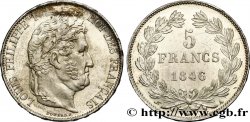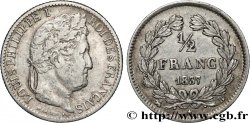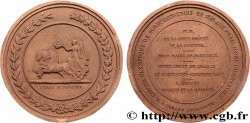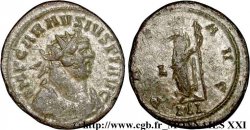E-auction 412-324337 - fme_423632 - LOUIS-PHILIPPE I Médaille, Avènement de Louis-Philippe
Чтобы принять участие в торгах, вы должны войти в систему и стать подтвержденным участником аукциона. Войдите, чтобы сделать ставку. Ваш аккаунт будет подтвержден в течение 48 часов. Не ждите до закрытия торгов, чтобы зарегистрироваться.Сделав ставку на данный товар, вы вступаете в юридическое соглашение на покупку выбранного товара и нажатием кнопки «Сделать ставку» подтверждаете принятие вами условий интернет-аукционов cgb.fr.
Ставка может бить сделана только в полном эквиваленте евро. Торги закроются согласно времени, указанному в описании товара, все ставки, сделанные после закрытия торгов, учитываться не будут. Не следует откладывать предложение вашей ставки до последнего момента, так как система может не успеть обработать вашу заявку, и ваша ставка не будет принята. Более детальную информацию вы найдёте здесь: FAQ по интернет-аукционам.
БЕСПЛАТНО.
БЕСПЛАТНО.
| Оценить : | 180 € |
| Цена : | 77 € |
| Максимальная предлагаемая цена : | 300 € |
| Конец торгов : | 08 March 2021 18:46:30 |
| Участников : | 9 Участников |
Тип Médaille, Avènement de Louis-Philippe
Дата: 1830
Монетный двор / Город: 75 - Paris
Металл: copper
Диаметр: 75 mm
Ориентация осей монеты: 12 h.
Гравер DEPAULIS Alexis-Joseph (1790-1867)
Вес: 215 g.
Век: lisse
Пуансон: sans poinçon
Комментарии о состоянии
Belle et large médaille avec une patine marron. La médaille présente plusieurs coups et rayures, ainsi qu’une légère usure sur les reliefs
Ссылки в каталоге: :
Лицевая сторона
Аверс: легенда: LVDOVICVS. PHILIPPVS. I - FRANCORVM. REX.
Аверс: описание: Tête laurée à droite de Louis-Philippe Ier. Signé : DEPAULIS. F. .
Обратная сторона
Реверс: легенда: PVBLICAE - CONCORDIAE - PIGNVS // MDCCCXXX.
Реверс: Описание: Dans le champ à gauche du trône royal, la France casquée debout, vêtue à l’antique, tenant à droite une statuette de la République timbrée LEX offre de la gauche la couronne à Louis-Philippe, situé à droite du trône, debout en uniforme. Il tend de la droite un rameau de laurier et retient de la gauche le drapeau tricolore. Signé : DEPAULIS. F. .
Комментарий
Médaille avec une tranche lisse, probablement d’époque, le système des poincons ayant été adopté en 1832.
En 1830, la révolution des « Trois Glorieuses » renverse Charles X, qui abdique (avec le contre-seing de son fils le dauphin Louis de France) en faveur de son petit-fils le duc de Bordeaux. Cependant les députés instituent le duc d’Orléans comme lieutenant-général du Royaume le 30 juillet 18306 et Charles X prend finalement le chemin de l'exil.
Louis-Philippe se fait proclamer roi des Français par la Chambre des députés le 9 août 1830, par la grâce d'une charte valant constitution. Ce nouveau titre, déjà porté par Louis XVI de 1789 à 1792, est une innovation constitutionnelle liant la nouvelle monarchie populaire au peuple, et non plus au pays, au territoire. Il s'agit donc d'une monarchie contractuelle fondée sur un Pacte entre le roi et les représentants de la nation. Un autre symbole fort de la nouvelle monarchie, appelée « monarchie de Juillet », est l’usage du drapeau tricolore pour remplacer le drapeau blanc de la Restauration. Cette arrivée au pouvoir à la faveur d’un soulèvement populaire vaut à Louis-Philippe l’hostilité des cours européennes et le surnom de « roi des barricades » ou encore « roi bourgeois »..
Medal with a smooth edge, probably from the period, the hallmark system having been adopted in 1832.
In 1830, the revolution of the \\\"Three Glorious Days\\\" overthrew Charles X, who abdicated (with the countersignature of his son, the Dauphin Louis of France) in favor of his grandson, the Duke of Bordeaux.. However, the deputies established the Duke of Orleans as Lieutenant-General of the Kingdom on July 30, 18306 and Charles X finally took the path of exile..
Louis-Philippe had himself proclaimed King of the French by the Chamber of Deputies on August 9, 1830, by virtue of a charter serving as a constitution.. This new title, already held by Louis XVI from 1789 to 1792, is a constitutional innovation linking the new popular monarchy to the people, and no longer to the country, to the territory. It is therefore a contractual monarchy based on a Pact between the king and the representatives of the nation. Another strong symbol of the new monarchy, called the \\\"July Monarchy\\\", is the use of the tricolor flag to replace the white flag of the Restoration. This rise to power thanks to a popular uprising earned Louis-Philippe the hostility of the European courts and the nickname \\\"king of the barricades\\\" or \\\"bourgeois king\\\"..
En 1830, la révolution des « Trois Glorieuses » renverse Charles X, qui abdique (avec le contre-seing de son fils le dauphin Louis de France) en faveur de son petit-fils le duc de Bordeaux. Cependant les députés instituent le duc d’Orléans comme lieutenant-général du Royaume le 30 juillet 18306 et Charles X prend finalement le chemin de l'exil.
Louis-Philippe se fait proclamer roi des Français par la Chambre des députés le 9 août 1830, par la grâce d'une charte valant constitution. Ce nouveau titre, déjà porté par Louis XVI de 1789 à 1792, est une innovation constitutionnelle liant la nouvelle monarchie populaire au peuple, et non plus au pays, au territoire. Il s'agit donc d'une monarchie contractuelle fondée sur un Pacte entre le roi et les représentants de la nation. Un autre symbole fort de la nouvelle monarchie, appelée « monarchie de Juillet », est l’usage du drapeau tricolore pour remplacer le drapeau blanc de la Restauration. Cette arrivée au pouvoir à la faveur d’un soulèvement populaire vaut à Louis-Philippe l’hostilité des cours européennes et le surnom de « roi des barricades » ou encore « roi bourgeois »..
Medal with a smooth edge, probably from the period, the hallmark system having been adopted in 1832.
In 1830, the revolution of the \\\"Three Glorious Days\\\" overthrew Charles X, who abdicated (with the countersignature of his son, the Dauphin Louis of France) in favor of his grandson, the Duke of Bordeaux.. However, the deputies established the Duke of Orleans as Lieutenant-General of the Kingdom on July 30, 18306 and Charles X finally took the path of exile..
Louis-Philippe had himself proclaimed King of the French by the Chamber of Deputies on August 9, 1830, by virtue of a charter serving as a constitution.. This new title, already held by Louis XVI from 1789 to 1792, is a constitutional innovation linking the new popular monarchy to the people, and no longer to the country, to the territory. It is therefore a contractual monarchy based on a Pact between the king and the representatives of the nation. Another strong symbol of the new monarchy, called the \\\"July Monarchy\\\", is the use of the tricolor flag to replace the white flag of the Restoration. This rise to power thanks to a popular uprising earned Louis-Philippe the hostility of the European courts and the nickname \\\"king of the barricades\\\" or \\\"bourgeois king\\\"..







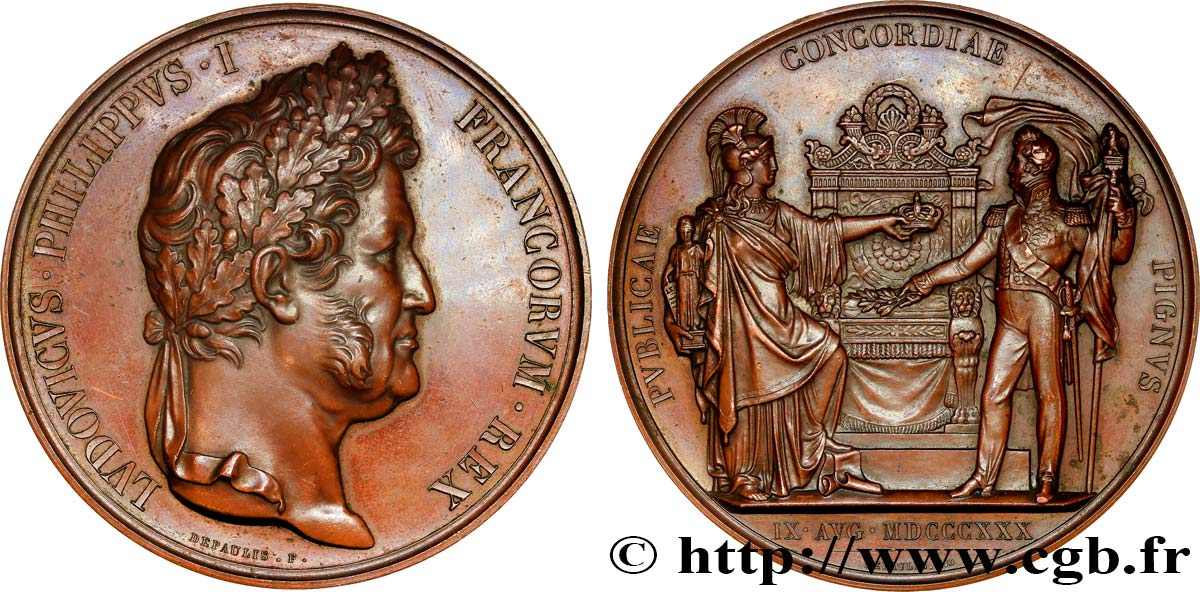
 Cообщить об ошибке
Cообщить об ошибке Распечатать страницу
Распечатать страницу Отправить мой выбор
Отправить мой выбор Задать вопрос
Задать вопрос Consign / sell
Consign / sell
 Информация
Информация